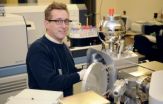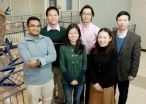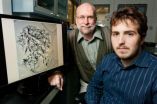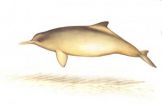(Press-News.org) For the first time in history, a change will be made to the atomic weights of some elements listed on the Periodic table of the chemical elements posted on walls of chemistry classrooms and on the inside covers of chemistry textbooks worldwide.
The new table, outlined in a report released this month, will express atomic weights of 10 elements - hydrogen, lithium, boron, carbon, nitrogen, oxygen, silicon, sulfur, chlorine and thallium - in a new manner that will reflect more accurately how these elements are found in nature.
"For more than a century and a half, many were taught to use standard atomic weights — a single value — found on the inside cover of chemistry textbooks and on the periodic table of the elements. As technology improved, we have discovered that the numbers on our chart are not as static as we have previously believed," says Dr. Michael Wieser, an associate professor at the University of Calgary, who serves as secretary of the International Union of Pure and Applied Chemistry's (IUPAC) Commission on Isotopic Abundances and Atomic Weights. This organization oversees the evaluation and dissemination of atomic-weight values.
Modern analytical techniques can measure the atomic weight of many elements precisely, and these small variations in an element's atomic weight are important in research and industry. For example, precise measurements of the abundances of isotopes of carbon can be used to determine purity and source of food, such as vanilla and honey. Isotopic measurements of nitrogen, chlorine and other elements are used for tracing pollutants in streams and groundwater. In sports doping investigations, performance-enhancing testosterone can be identified in the human body because the atomic weight of carbon in natural human testosterone is higher than that in pharmaceutical testosterone.
The atomic weights of these 10 elements now will be expressed as intervals, having upper and lower bounds, reflected to more accurately convey this variation in atomic weight. The changes to be made to the Table of Standard Atomic Weights have been published in Pure and Applied Chemistry and a companion article in Chemistry International.
For example, sulfur is commonly known to have a standard atomic weight of 32.065. However, its actual atomic weight can be anywhere between 32.059 and 32.076, depending on where the element is found. "In other words, knowing the atomic weight can be used to decode the origins and the history of a particular element in nature," says Wieser who co-authored the report.
Elements with only one stable isotope do not exhibit variations in their atomic weights. For example, the standard atomic weights for fluorine, aluminum, sodium and gold are constant, and their values are known to better than six decimal places.
"Though this change offers significant benefits in the understanding of chemistry, one can imagine the challenge now to educators and students who will have to select a single value out of an interval when doing chemistry calculations," says Dr. Fabienne Meyers, associate director of IUPAC.
"We hope that chemists and educators will take this challenge as a unique opportunity to encourage the interest of young people in chemistry and generate enthusiasm for the creative future of chemistry."
The University of Calgary has and continues to contribute substantially in the study of atomic weight variations. Professor H. Roy Krouse created the Stable Isotope Laboratory in the Department of Physics and Astronomy in 1971. Early work by Krouse established the wide natural range in the atomic weight of significant elements including carbon and sulfur. Currently, researchers at the University of Calgary in physics, environmental science, chemistry and geoscience are exploiting variations in atomic weights to elucidate the origins of meteorites, to determine sources of pollutants to air and water, and to study the fate of injected carbon dioxide in geological media.
This fundamental change in the presentation of the atomic weights is based upon work between 1985 and 2010 supported by IUPAC, the University of Calgary and other contributing Commission members and institutions.
INFORMATION:
The year 2011 has been designated as the International Year of Chemistry. The IYC is an official United Nations International Year, proclaimed at the UN as a result of the initiative of IUPAC and UNESCO. IUPAC will feature the change in the standard atomic weights table as part of associated IYC activities.
Atomic weights of 10 elements on periodic table about to make an historic change
Researchers from around the world compile more reliable data that will help science and industry
2010-12-16
ELSE PRESS RELEASES FROM THIS DATE:
Soft substrate promotes pluripotent stem cell culture
2010-12-16
CHAMPAIGN, Ill. — University of Illinois researchers have found a key to keeping stem cells in their neutral state: It takes a soft touch.
In a paper published in the journal PLoS One, the researchers demonstrated that culturing mouse embryonic stem cells (mESCs) on a soft gel rather than on a hard plate or dish keeps them in their pluripotent state, a ground state with the ability to become any type of tissue. The soft substrate maintains homogeneous pluripotent colonies over long periods of time – without the need for expensive growth chemicals.
"This has huge applications ...
Warning lights mark shellfish that aren't safe to eat
2010-12-16
Red tides and similar blooms can render some seafood unsafe to eat, though it can be difficult to tell whether a particular batch harbors toxins that cause food poisoning.
A new kind of marker developed by chemists at the University of California, San Diego, and reported in the journal ChemComm makes it easier to see if shellfish are filled with toxin-producing organisms.
Mussels and oysters accumulate single-celled marine creatures called dinoflagellates in their digestive systems as they filter seawater for food. Usually dinoflagellates are harmless, but sometimes ...
New method for making tiny catalysts holds promise for air quality
2010-12-16
CHAMPAIGN, Ill. — Fortified with iron: It's not just for breakfast cereal anymore. University of Illinois researchers have demonstrated a simpler method of adding iron to tiny carbon spheres to create catalytic materials that have the potential to remove contaminants from gas or liquid.
Civil and environmental engineering professor Mark Rood, graduate student John Atkinson and their team described their technique in the journal Carbon.
Carbon structures can be a support base for catalysts, such as iron and other metals. Iron is a readily available, low-cost catalyst ...
Researchers discover compound with potent effects on biological clock
2010-12-16
Using an automated screening technique developed by pharmaceutical companies to find new drugs, a team of researchers from UC San Diego and three other research institutions has discovered a molecule with the most potent effects ever seen on the biological clock.
Dubbed by the scientists "longdaysin," for its ability to dramatically slow down the biological clock, the new compound and the application of their screening method to the discovery of other clock-shifting chemicals could pave the way for a host of new drugs to treat severe sleep disorders or quickly reset the ...
Membership in many groups leads to quick recovery from physical challenges
2010-12-16
Los Angeles, CA (December 15, 2010) Being a part of many different social groups can improve mental health and help a person cope with stressful events. It also leads to better physical health, making you more able to withstand—and recover faster from—physical challenges, according to a study in the current Social Psychological and Personality Science (published by SAGE).
Belonging to groups, such as networks of friends, family, clubs and sport teams, improves mental health because groups provide support, help you to feel good about yourself and keep you active. But ...
Concussed high school athletes who receive neuropsychological testing sidelined longer
2010-12-16
Los Angeles, CA (December 15, 2010) When computerized neuropsychological testing is used, high school athletes suffering from a sports-related concussion are less likely to be returned to play within one week of their injury, according to a study in The American Journal of Sports Medicine (published by SAGE). Unfortunately, concussed football players are less likely to have computerized neuropsychological testing than those participating in other sports.
A total of 544 concussions were recorded by the High School Reporting Information Online surveillance system during ...
New study about Arctic sea-ice, greenhouse gases and polar bear habitat
2010-12-16
ANCHORAGE, Alaska – Sea-ice habitats essential to polar bears would likely respond positively should more curbs be placed on global greenhouse gas emissions, according to a new modeling study published today in the journal, Nature.
The study, led by the U.S. Geological Survey, included university and other federal agency scientists. The research broke new ground in the "tipping point" debate in the scientific community by providing evidence that during this century there does not seem to be a tipping point at which sea-ice loss would become irreversible.
The report ...
Meteorite just one piece of an unknown celestial body
2010-12-16
Washington, D.C.—Scientists from all over the world are taking a second, more expansive, look at the car-sized asteroid that exploded over Sudan's Nubian Desert in 2008. Initial research was focused on classifying the meteorite fragments that were collected two to five months after they were strewn across the desert and tracked by NASA's Near Earth Object astronomical network. Now in a series of 20 papers for a special double issue of the journal Meteoritics and Planetary Science, published on December 15, researchers have expanded their work to demonstrate the diversity ...
Where unconscious memories form
2010-12-16
A small area deep in the brain called the perirhinal cortex is critical for forming unconscious conceptual memories, researchers at the UC Davis Center for Mind and Brain have found.
The perirhinal cortex was thought to be involved, like the neighboring hippocampus, in "declarative" or conscious memories, but the new results show that the picture is more complex, said lead author Wei-chun Wang, a graduate student at UC Davis.
The results were published Dec. 9 in the journal Neuron.
We're all familiar with memories that rise from the unconscious mind. Imagine looking ...
New research shows dolphin by-catch includes genetic relatives
2010-12-16
Dolphins along coast of Argentina could experience a significant loss of genetic diversity because some of the animals that accidently die when tangled in fishing nets are related. According to a new genetic analysis published this week in the journal PLoS One, Franciscana dolphins that die as by-catch are more than a collection of random individuals: many are most likely mother-offspring pairs. This result, which suggests reduced genetic diversity and reproductive potential, could have significant implications for the conservation of small marine mammals.
"It has always ...
LAST 30 PRESS RELEASES:
Scientists trace microplastics in fertilizer from fields to the beach
The Lancet Obstetrics, Gynecology, & Women’s Health: Taking paracetamol during pregnancy does not increase risk of autism, ADHD or intellectual disabilities, confirms new gold-standard evidence review
Taking paracetamol during pregnancy does not increase risk of autism, ADHD or intellectual disabilities
Harm reduction vending machines in New York State expand access to overdose treatment and drug test strips, UB studies confirm
University of Phoenix releases white paper on Credit for Prior Learning as a catalyst for internal mobility and retention
Canada losing track of salmon health as climate and industrial threats mount
Molecular sieve-confined Pt-FeOx catalysts achieve highly efficient reversible hydrogen cycle of methylcyclohexane-toluene
Investment in farm productivity tools key to reducing greenhouse gas
New review highlights electrochemical pathways to recover uranium from wastewater and seawater
Hidden pollutants in shale gas development raise environmental concerns, new review finds
Discarded cigarette butts transformed into high performance energy storage materials
Researchers highlight role of alternative RNA splicing in schizophrenia
NTU Singapore scientists find new way to disarm antibiotic-resistant bacteria and restore healing in chronic wounds
Research suggests nationwide racial bias in media reporting on gun violence
Revealing the cell’s nanocourier at work
Health impacts of nursing home staffing
Public views about opioid overdose and people with opioid use disorder
Age-related changes in sperm DNA may play a role in autism risk
Ambitious model fails to explain near-death experiences, experts say
Multifaceted effects of inward foreign direct investment on new venture creation
Exploring mutations that spontaneously switch on a key brain cell receptor
Two-step genome editing enables the creation of full-length humanized mouse models
Pusan National University researchers develop light-activated tissue adhesive patch for rapid, watertight neurosurgical sealing
Study finds so-called super agers tend to have at least two key genetic advantages
Brain stimulation device cleared for ADHD in the US is overall safe but ineffective
Scientists discover natural ‘brake’ that could stop harmful inflammation
Tougher solid electrolyte advances long-sought lithium metal batteries
Experts provide policy roadmap to reduce dementia risk
New 3D imaging system could address limitations of MRI, CT and ultrasound
First-in-human drug trial lowers high blood fats
[Press-News.org] Atomic weights of 10 elements on periodic table about to make an historic changeResearchers from around the world compile more reliable data that will help science and industry



